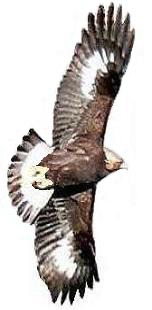Osprey
(Pandion haliaetus)
Migration Timeframe:
Osprey
migration
begins in late August, increasing in early
September, and peaking by mid September. Females usually
migrate ahead of the males. Their numbers start a slow
decline from mid to late September, and then taper off through
early to mid October. Basically, Osprey migration ends
mid-October with VERY few migrating through during November. None have
ever been recorded at the hawkwatch in December.
|
Year |
Peak Week |
Avg |
|
2002-2007 |
Sep 15-21 |
66 |
|
Year |
Peak Week |
Count |
|
2008 |
Sep 15-21 |
79 |
|
Year |
Earliest
Obs |
Count |
Year |
Latest
Obs |
Count |
|
2002-2007 |
Aug 31 2007 |
2 |
2002-2007 |
Nov 14 2006 |
1 |
|
2008 |
Aug 25 |
1 |
2008 |
Nov 1 |
1 |
Where to Watch:
Ospreys are another species that you'll
most often spot cruising along above the cliff edge, using the
updrafts of south and southwest winds hitting the cliff face. They
may also be observed soaring with other raptors in kettles in thermals
forming over flat farmland to the east and north of the hawkwatch.
They're very distinctive in flight, holding their wings in what
looks like a "W" shape. This makes them easy to identify at great
distances. Their plumage is also distinctive which aids in easier
identification.
High Counts:
Though no new records were set for Osprey in the 2008 season.
However, they continue to
make a strong showing. .
|
1-Year |
Count |
1-Month |
Count |
|
2005 |
361 |
Sep 2005 |
318 |
|
1-Day |
Count |
1-Hour |
Count |
|
Sep 17 2005 |
57 |
Sep 17 2005 |
14 |
Yearly Totals:
The 2008 yearly total was just 3 birds more than the 2007
total...how wild is that? It was still ahead of the 10-year average but just under the 5-year average. (averages are based on 1998-2007 and
2003-2007 counts).
|
Year |
Count |
Year |
Count |
Year |
Count |
|
1995 |
196 |
2000 |
98 |
2005 |
361 |
|
1996 |
131 |
2001 |
155 |
2006 |
278 |
|
1997 |
109 |
2002 |
226 |
2007 |
209 |
|
1998 |
101 |
2003 |
114 |
2008 |
212 |
|
1999 |
124 |
2004 |
140 |
2009 |
N/A |
|
10-Yr Avg |
5-Yr Avg |
|
181 |
220 |
Interesting Facts:
-
Ospreys have barbed talons which allows them to better hang
onto fish that they've captured
-
Unfortunately, they've been known to get into trouble by
hooking into a fish that's too heavy to lift out of the
water...and because their talons are barbed they're unable
to release the fish and can drown as a result
-
most Osprey winter in the “South”, though
some stay within North America (i.e. along the Gulf coast
in southern Florida, and in central and southern
California).
-
Northern adult breeding populations
winter from the southern U.S. southward to southern Brazil,
Bolivia and Peru.
-
Juveniles winter from Cuba to Belize and
southward to South America as described for adults.
-
Juveniles remain at their winter grounds
until the spring of their second year.
-
Females are noticeably larger than males
|
